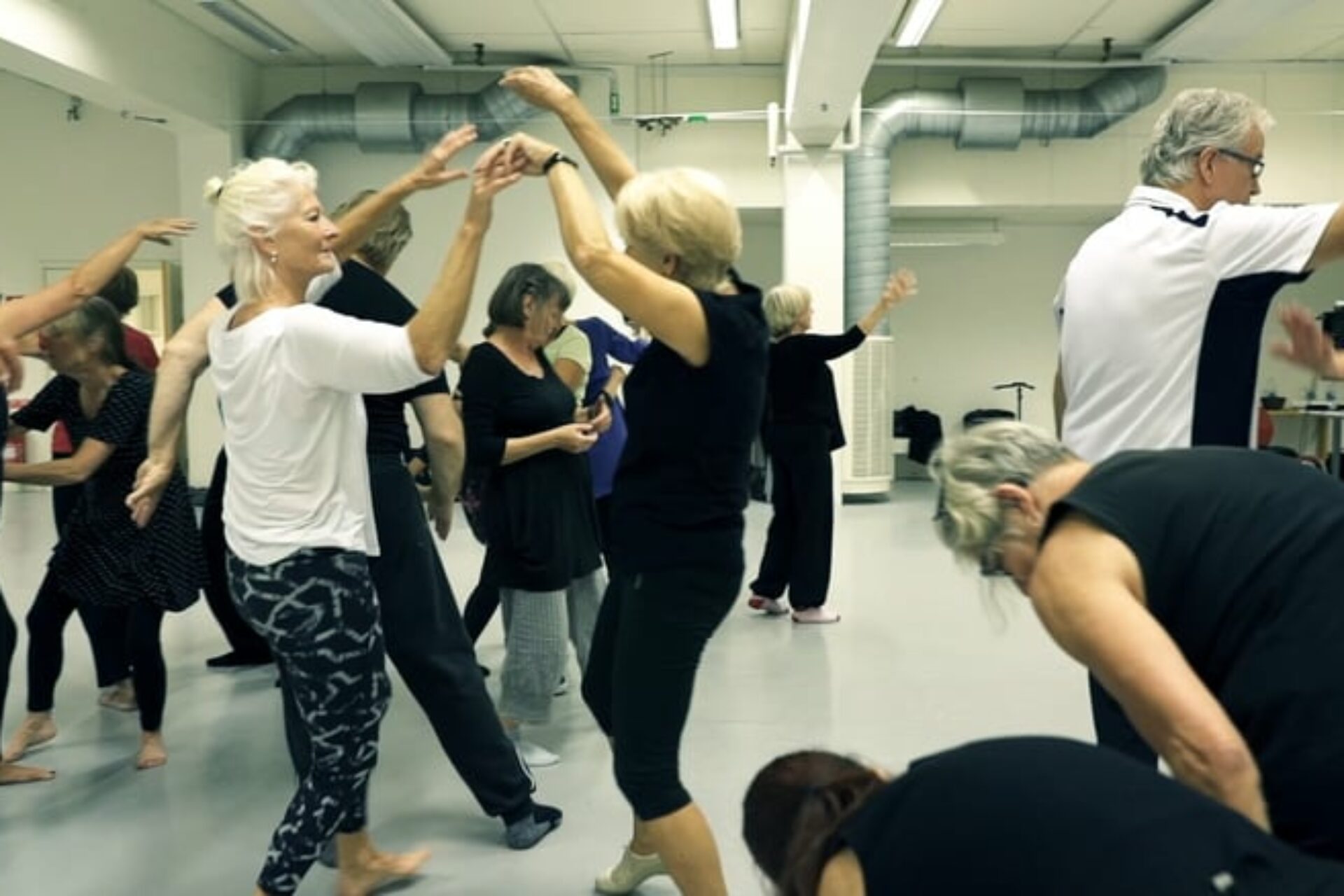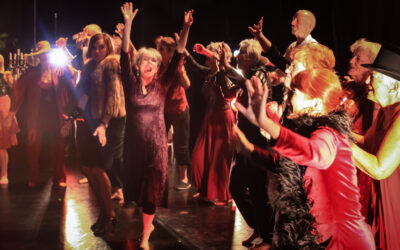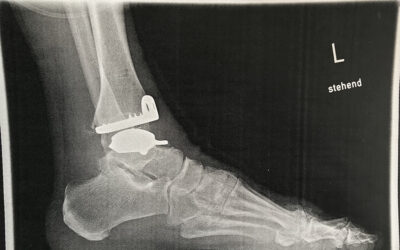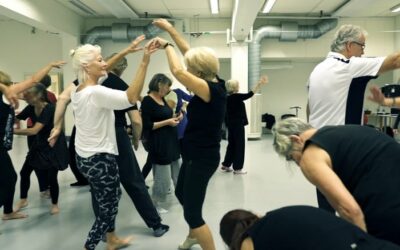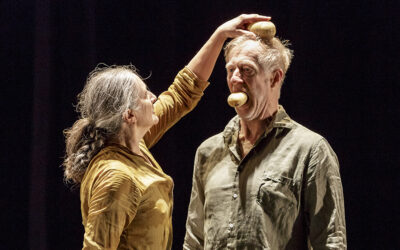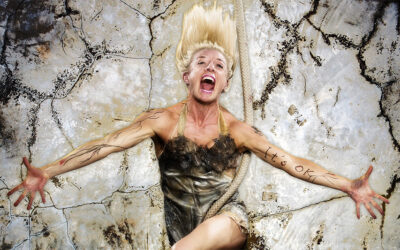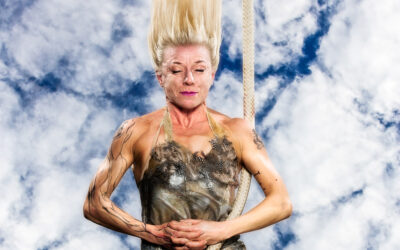AGE ON STAGE – THE RESEARCHER’ VIEW
As collaborative researchers during the conducted workshop series, given by a Charlotta Öfverholm, offered for people 65+, we conducted four studies. The first one focused the choreographer, and the second one on the participants’ experiences, the third one will focus on experiences among women from Norrbotten, and the fourth on upon the creative process toward a performance.
Hitherto, research regarding music and dance in relation to elderly people can be divided into three focus areas, namely treatment, therapy, and well-being. Still, it seems to be important to focus on the role of the teacher in such settings, and partly to enlighten artistic dimensions of music and dance as forms of expressions available for elderly people from an equality point of view.
Two studies have so far been conducted, based on the first workshop week which took place during one week in Sweden in the fall 2016 with 25 elderly non-professional dancers. The analysis of the first study resulted in four themes which show that the choreographer influences possibilities for participation regarding how workshops are designed and what inputs that are given in the process, what atmosphere that is created, how the participants are to use their bodies, and how dance as artistic form of expression is offered.
The result of the second study, can be presented in four themes, which constitute the ground for a discussion about dance as an aesthetic and democratic form of expression among people 65+, namely; A functional body with impetus to move, To embody dance as a form of expression, To use dance as an artistic art form in aesthetic communication, and Dance reflections. It can be stated that elderly dance participants in the first case are and should be treated as all other human beings, but their comprehensive experiences and awareness of how their bodies function, has to be taken care of and given space. It’s a human right to express oneself in and through artistic forms, and the task for the choreographer is to create functional, safe and encouraging circumstances.
THE FULL STUDY:
Age on stage – the researchers’ views
As collaborative researchers during the conducted workshop series, given by a Charlotta Öfverholm, offered for people 65+, three studies were conducted. The first one focused the choreographer, and the second one on the participants’ experiences. The third one, which is in progress and lean upon the two previous, concerns the communicative process of developing a stage performance. Hitherto, research regarding music and dance in relation to elderly people can be divided into three focus areas, namely treatment, therapy, and well-being. The latter is most often investigated within the frame of “community dance or music” or defined as “adult music or dance education.” Elderly people’s’ activities as audience, performers, composers or directors have constituted the research objects in these studies. The study’s results showed that engagement in music or dance activities can help persons to connect with their life experiences, increase empowerment and agency, and encourage well-being in several ways; socially, emotionally, and cognitively. Although there is an agreed upon need for initiatives that support elderly people’s well-being, researchers state that little attention has been paid to the role of those facilitating such activities. Hence, partly it seems to be important to focus on the role of the teacher in such settings, and partly to enlighten artistic dimensions of music and dance as forms of expressions available for elderly people from an equality point of view. In the following we will shortly present the two finished studies, which are to be published in scientific journals. These studies were based on the first workshop week which took place during one week in Sweden in the fall 2016 with 25 elderly non-professional dancers. In the end of the workshop week the dancers presented their created dance piece during a studio performance.
Study 1:
To offer dance as aesthetic experience and communication among people 65+
Based on theories regarding aesthetic experience and communication the workshop series, was studied and explored in close collaboration. The specific aim of the study is to explore the role of the teacher regarding to offer participation in dance as an artistic art form among elderly people.
Method
To be able to elaborate upon the role of the teacher aiming to offer participation in dance activities, written material was produced based on one interview with the teaching choreographer, six interviews including two male and four female participating dancers, complemented by field notes and video recordings. The material was analysed in a phenomenological hermeneutic way. The analysis process comprised naïve reading, structured analysis, comprehensive understanding, and the formulation of results in a holistic manner. In other words the produced texts were firstly read several times in order to grasp their meaning as a whole, by the two researchers respectively. This naive reading was followed by a phase of structural analysis, which can be seen as a way of identifying and formulating themes, and which provided opportunities for testing emerged concepts, made in cooperation. A theme is a thread of meaning that penetrates parts of a text in the process of conveying the essential meaning of lived experience. The process was finished when the themes validated and deepened the naive reading. Then the main themes and constituting aspects were summarized and reflected upon in relation to the research question and the context of the study, and finally the last step concerned formulating the result in everyday language, used by the participants.
Result
The phenomenological analysis generated four main themes that picture the role of the teacher when it comes to offer participation in dance as an artistic art form among elderly people 65+. The themes state that the teacher influences possibilities for participation regarding how workshops are designed and what inputs that are given in the process, what atmosphere that is created, how the participants are to use their bodies, and how dance as artistic artform is offered.
The most important aspects of design and of teacher inputs in the dance activities appeared to be teacher approach, communication tools, life-stories, music, and progression. The approach of the teacher in the study can be defined as being constituted by professionalism, explicitness, naturalism, presence, risk taking, energy, warmth, curiosity, encouragement, caring, and adaptation. Communication tools used were dance vocabulary, body movements, mirrors and metaphors. In beforehand the participants were asked to write and share life stories that could concern simple everyday topics, or deep experiences, which were used as grounds for improvisations. Chosen musical pieces were used as inspiration and guidance in connection to all kinds of dance activities. When it comes to task and progression, both technical, personal and communicative skills were trained, used and developed throughout the workshop. Warming up activities, a choreography, and improvisation were combined in each class. The mix of steered and free activities was appreciated by the participants. The atmosphere seemed to be an important theme, according to both the teacher and the participants. The atmosphere was constituted by freedom, open sharing, a sense of equal age, and playful seriosity. The participants expressed that the expected co-operation with unknown people went smoothly. It also became clear that the common age of the participants influenced the atmosphere. The aspect of playful seriosity consists of prestigelessness and playfulness, which contributed to safeness. In turn the safeness allowed the group to be curious, to let go, and play.
The theme body was brought to attention both by the teacher and the participants. It seemed that the body were seen both as including possibilities and as limitations. Aspects that emerged of the theme body were earlier experiences, awareness, health, and dance impetus. The participants had limited earlier experiences from using their bodies in dance as aesthetic communication, and therefore were rather unfamiliar to the context. Awareness was brought to attention and revolved around presence in the body in various ways, including memorizing movements and movement patterns, the participants’ own learning process with and through the body and awareness of their progression. The participants also emphasized dance as a form of impetus for bodily movement and well-being.
Dance as a form of expression was brought to attention both by the teacher and the participants. The theme dance as a form of expression was constituted by variety of movement language, variety of expressions, emotions, individual/collective communication, and exploration. The participants were offered to try out various ways to move and express themselves in dance, both through improvisation and given choreography. The participants expressed that they discovered, developed and dealt with their expression of emotions during this dance experience, both as individuals and as a group. The participants got the chance to explore their own but also others dance expressions.
Discussion
The study presented in the first article aimed to contribute to a discussion regarding possibilities and limitations concerning opportunities for dance as an artistic art form among elderly people. The result of the study have shed light on some crucial aspects concerning design of such an environment. The importance of safeness and let go, in playful seriousity, where limitations are taken away and elderly people actually can take part on equal grounds seems to be crucial.
The choreographer created prerequisites for the participants to experience their possibilities and limitations in dance. This seemed to be possible through offering a context where elderly people could explore dance as an aesthetic experience and communication, by a combination of inputs, atmosphere, bodily atmosphere where people dwelled in dance as an artistic form of expression.
A progression in bodily awareness became visible through observations and the participants’ own expressions. The participants used the offered dance as an artistic form of expression in aesthetic experience and communication, where they got control over their body, and got to know themselves and each other, physically, emotionally and existentially. One implication was that the emotional, existential and aesthetic aspects of aesthetic communication, could be illuminated to a higher degree by the theory of aesthetic communication.
Study 2:
“To get the chance to dance myself” – dance as democracy among people 65+
This study presents results of research, where elderly people, with mixed experience of dance, were offered to learn, and express themselves through, dance as an artistic expression. As a philosophical lens Arendt’s view of democracy was used. The specific aim of the study was to shed light on contemporary dance as democracy among people 65+ from a participant perspective.
Method
To be able to come close to the lived worlds of the dancers, the workshop series were observed and documented through written notes and video recordings. A first analysis of the notes resulted in two descriptions of the phenomenon which were compared and developed in joint analysis. Two 2-hour sessions, as well as the final performance, were chosen for closer analysis.
The material was analysed in a phenomenological hermeneutic manner. The analysis process comprised naïve reading, structured analysis, comprehensive understanding, and the formulation of results in a holistic manner. In other words the notes and videos were firstly read and viewed several times in order to grasp their meaning as a whole. The naıve understanding of the text was formulated in an Ariendtian language whereby concepts of vita activa, vita contemplativa and common sense, enabled reflection and depth analysis of the material in relation to the theory of democracy. This followed by a phase of structural analysis, which can be seen as a way of identifying and formulating themes, and which provided opportunities for testing emerged concepts. The process was finished when the themes validated and deepened the naive reading. Then the main themes and constituting aspects were summarized and reflected upon in relation to the research question and the context of the study, and finally the last step concerned formulating the result in everyday language, used by the participants. The last step was to find holistic examples that showed the different sides of the phenomenon in concrete ways.
Result
The result is presented in accordance with Arendt’s different levels of action, and reflections, translated to the dance context. The themes that emerged in the study are A functional body with impetus to move, To embody dance as a form of expression and To use Dance as a Form of Artistic Expression in Aesthetic Communication, together with Reflections over life, body and dance.
A Functional Body with an Impetus to move
This theme includes aspects of knowledge that are possible to develop within the level of Labour, namely body, space and time. The participants were offered to use their bodies in various ways to reach or maintain a controlled body both in already set movement sequences and improvisational activities with already set framework. The participants were encouraged to use various directions in space as a way to control the body in relation to the physical room and other dancers. Time was an aspect that included precision in timing but also timing in relation to others´ movement.
To embody dance as a form of expression
This theme includes aspects how to use the body as a dance instrument within the level of Work, namely framework, dance terminology and progression. The framework of the workshop included both improvisation and already set movement sequences. Improvisation was inspired by participants life stories, various music, body contact as well as the parameters body, space and time. The movements included technical challenges, where the choreographer showed an open approach to the different bodily limitations. The choreographer used dance terminology, including movement language and technical terms that is commonly used in a dance context, which gave the participants access and possibility to get understanding of, and use terminology within a dance context. Throughout the week it was possible to see a progression both in memory, awareness and body control. These aspects were intertwined though they work together as a whole when it comes to the participants ability to express themselves in dance.
To use Dance as a Form of Artistic Expression in Aesthetic Communication
This theme shows the Political life, how the participants communicated and dwelled together in dance as an artistic form of expression, how they communicated and became themselves in interaction in the dance room seen as a public space, in the end of the week. Individual Improvisation, as well as in pairs and groups, together with choreography constituted the activity frames of this theme. The dancers seemed to learn and develop through exploration, through each other, with images, metaphors and each other’s experiences and stories.
Dance Reflections
Contemplative activities took place before, during and after the workshop series, mainly as verbal, written and bodily reflections. Reflection activities was encouraged by the teacher, but also occurred in the dance activities per se. The participants reflections over life though they were improvising inspired by life stories and shorter words, written by the participants. In the process of creating the stories the dancers had to reflect upon their lives, and in the process of creating dance expressions built upon the stories and word they had to use their own life experiences to create a feeling that in turn could be used as inspiration in the improvisation. The dance expressions per se could also be seen as reflections upon life. The participants also encouraged to reflect over their body, both their own and others’ (old) bodies. Both directly by the choreographer´s instructions, their own discovery of what they were able to do with their bodies and how their ideas of a movement really turned out.
Discussion
The dance workshop can be seen as a place where elderly people were to develop technical skills, dance expressions, common growth and functional performances, through sharing each other’s ideas, experiences and expressions in dance. In accordance with Arendt’s theory, the result was seen as three levels including basic parameters in movement, the use of the body as a dance instrument, and the participants communication in dance as an artistic form of expression. We have seen how structures for participation, different roles and holdings created a place for expressions, mutual listening, thinking and common sense. To make this possible, in places that are steered by traditions, and strongly agreed upon norms, structures, braveness, engaged participation and trust are demanded. The performance survives the participants, although it has no goal in itself. At the same time dance learning was taking place at all three mentioned levels of activity, in the spirit of common sense, where actions and reflections were intertwined.
Summing up
Based on the two studies it can be stated that the responsibility for the choreographer was to shift between different roles, aiming to encourage common sense in the public place, to offer possibilities for the participating dancers to embody and develop dance as an artistic form of expression. One the one hand she had to be curious about the participants’ earlier experiences, backgrounds, growth and sharing, and on the other hand to offer structures for internalising of dance as an form of artistic expression, such as concepts, traditions, styles and culture, in relation to the old bodies. She had to be free and to encourage freedom, within the pluralistic common place where personal ideas and common expressions were treated and investigated.


